Japan
Wood Products Prices
Dollar Exchange Rates of 25th
February 2016
Japan Yen 112.99
Reports From Japan
GDP data challenges government and central
bank
GDP in Japan fell 0.4% in the final quarter of 2015,
dragged down by weak private consumption and the slow
housing market. The last quarter 2015 data were worse
than expected and pose a major challenge to the
government and the central bank. Figures show that
domestic consumption fell, as did public investment.
While residential investment fell private non-residential
investment was shown to have grown which helped soften
the negative GDP data.
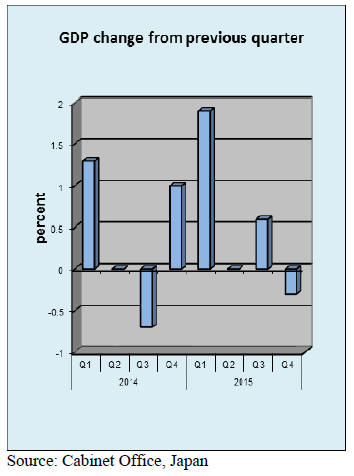
Flat-lined oil price steadies Yen/dollar exchange
rate
The yen has gained around 7% against the dollar since
January this year as investors have been pouring money
into Japan as a safe haven. The risk of Britain’s exit from
the EU along with wider global issues have driven a flood
of money to Japan which is threatening progress in the
government’s daring strategies to pull Japan out of
deflation.
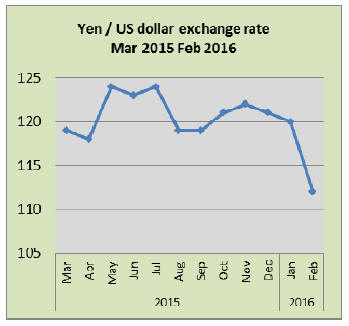
At one point the yen was around 111 to the dollar
but has
since weakened slightly as oil prices appear to have
leveled out. A strong yen hurts the competitiveness of
Japanese exporters and if the rate hovers at the 110 level it
is likely the Bank of Japan will act to try and drive down
the yen.
Negative interest rates stimulate mortgage enquiries
Perhaps the brightest note after Japan’s central bank drove
interest rates below zero is that it has spurred an interest in
the remortgaging of homes. Many analysts are forecasting
that enquiries for new home mortgages will rise which
would boost the housing market.
But, say financial planners, housing loan interest rates are
already very low and it is unlikely the banks would be
prepared to sacrifice profits by offering even lower rates to
home buyers.
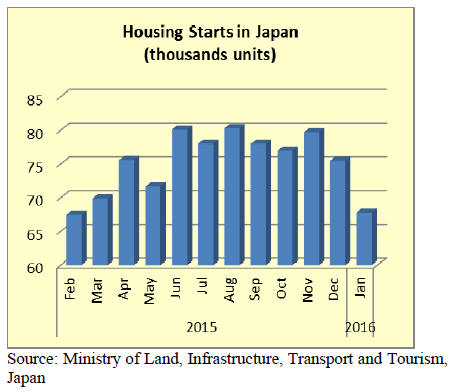
2015 Import round up
Doors
2015 saw a 4% decline in imports of wooden doors
marking the third straight annual fall in imports.
Throughout 2015 China was the largest wooden door
supplier to Japan securing 63% of all imports beating out
the Philippines (14%), Indonesia (8%) and Malaysia
(6.5%).
These top four suppliers of wooden doors accounted for
over 90% of all wooden door imports. Suppliers in SE
Asia accounted for 29% of Japan’s wooden door imports.
Even though housing starts have been flat the value of
wooden door imports has been increasing especially from
mid-2015 suggesting imports are capturing a greater share
of the wooden door market.

Windows
As is the case for doors, wooden window frame imports
have trended down for the past three years. In 2015
wooden window frame imports were down almost 15%
year on year.
The top four suppliers of wooden window frames in 2015
were, in order of rank, China, Philippines, USA and
Sweden accounting for 26%, 28%, 23% and 6%
respectively. The sources of supply of wooden window
frames is more diverse than for either wooden doors or
assembled wooden flooring.
Suppliers in the EU accounted for around 10% of 2015
imports of wooden window frames by Japan and the S.E.
Asian suppliers accounted for 31% of wooden window
frame imports.
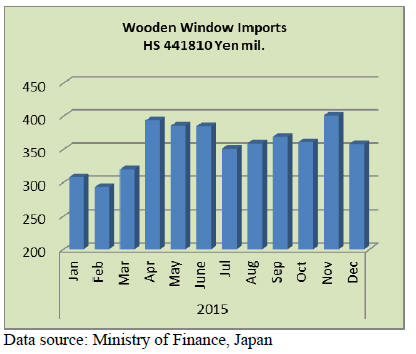
Assembled flooring
Japan’s assembled wooden flooring imports fall under 3
categories: HS441871, Assembled Flooring Panels for
mosaic flooring, HS 441872, Other Multilayered
Assembled Flooring Panels and HS 44179, Assembled
Flooring not falling in HS 441871 or HS441872.
Some 68% of Japan’s assembled wooden flooring in 2015
was recorded as HS441872 the balance being HS 441879
(30%) and HS 441871 (2%).
Of imports of HS441872, 74% came from China, 6% from
Sweden and 3% from Malaysia. Suppliers in SE Asia
accounted for 8.5% of 2015 imports while suppliers in the
EU accounted for 15%.
Of imports of HS441879, Indonesia was the largest
supplier in 2015 (29%) closely followed by China (27%),
Thailand (22%) and Vietnam (15%). The top four
suppliers accounted for 93% of imports of HS 441879.
Imports of HS 441871 are small and the main suppliers in
2015 were Thailand, Indonesia and Italy.
2015 imports of all three categories of assembled wooden
flooring (HS 441871-79) were down 34% from a year
earlier. Imports in 2014 were high, climbing 22% on 2013
levels but 2014 imports are an anomaly as the value of
annual imports has settled back to a general downward
trend.
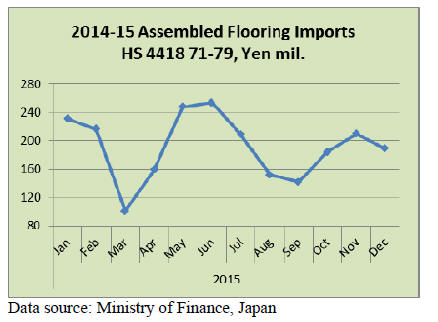
Plywood
Compared to 2014 plywood imports in 2015 fell 21% .
The top three supply countries, China, Malaysia and
Indonesia account for the bulk (95%) of Japan’s plywood
imports in 2015, a picture that has been repeated for the
past decade.

Malaysian suppliers secured the greatest propertion
of
Japan’s 2015 demand for imported plywood at 54%
follwed by Indonesia (35%) with smaller volumes coming
form China (8%).
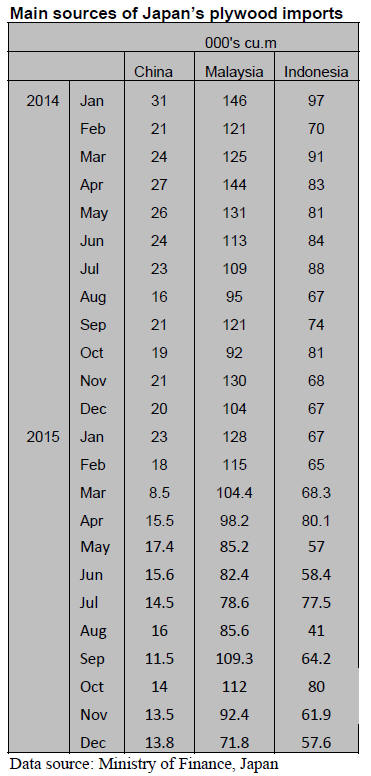
Trade news from the Japan Lumber Reports (JLR)
For the JLR report please see:
http://www.nmokuzai.
com/modules/general/index.php?id=7
2015 plywood supply
Total plywood supply in 2015 was 5,656,100 cbms, 10.2%
less than 2014. This is the first time that total volume
dropped below the level of six million cbms after five
years since 2010.
Specifically, imported plywood was the lowest in six years
since 2009 with 2,885,700 cbms, 17.3% less than 2014.
Meantime, domestic plywood production was slightly
down from previous year with 2,770,300 cbms, 1.3% less
than 2014. Accordingly, share of imported plywood
dropped down to 51%.
Domestic production dropped in 2009 and 2011 but since
then it has held steady pace so sharp drop of imported
plywood was the reason of drop of total supply in 2015.
There is no clear reason why demand for imported
plywood declined this much. General explanation is that
the source of tropical hardwood logs has been declining
then severe control on illegal harvest in.
Sarawak, Malaysia further reduced log harvest then
resultant high export prices become chronic so the users in
Japan have been shifting to domestic softwood plywood.
However, it is hard to explain when imported plywood
volume decreased by 17% and domestic plywood
shipment increased only by 6%.
The volume from Malaysia was the lowest since 1996.
Indonesian volume dropped below one million cbms, first
time that the volume dropped below one million cbms in
five years since 2010 then the volume from China also
recorded the lowest in five years.
Domestic softwood plywood production was 1.1% less
than 2014 but the shipment was up by 6.7%. In the first
half of the year, the demand was slow so that the
production exceeded the shipment and the inventory
swelled up to 260,000 cbms then in the second half of the
year, the demand picked up so that the production could
not catch up the shipment so the inventory had been
decreasing month after month.
It is totally different pattern in the first half and second
half. With very active demand in the second half, many
items were short in supply and the mills’ inventory was
minimal.
 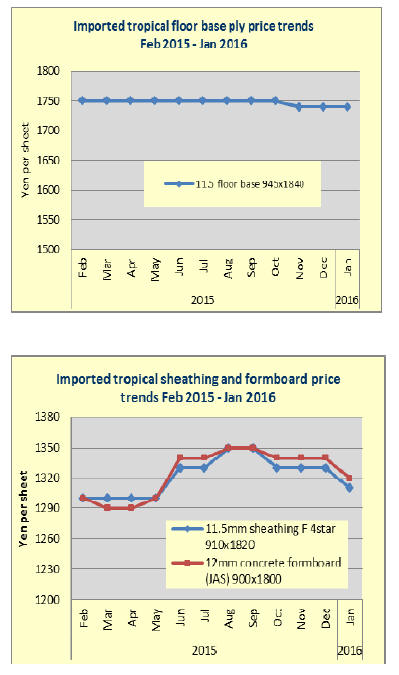
South Sea (Tropical) logs
Malaysia is in rainy season now and before Chinese New
Year starts, log suppliers are not so anxious to operate
logging activities thus late January log supply was low.
Bearish log market until last December stopped in January
so it is leveling off now. Actually besides foul weather,
low log prices discourage log suppliers so that log
production dropped considerably.
The Japanese log importers want to buy quality logs but
with limited supply, they have to take what’s available as
local suppliers’ log inventories are extremely low. Some
importers say that a ship is coming in three days but there
are not enough logs.
To fill up a ship, they have to make three ports loading so
it is risky attempt now without enough logs on hand before
a ship comes in. The worst case is that a ship has to wait
until logs become available at loading port.
Since January this year, in Sarawak as a part of controlling
illegal harvest, harvest quota becomes monthly base as
compared to quarterly allocation or yearly quota and any
harvest volume exceeding monthly quota is not allowed to
carry over to next month so log suppliers probably harvest
90 to 95 % of quota volume so log supply is likely to
decline more by this system.
Present FOB prices for export logs are US$265-275 per
cbm on meranti regular,US$245 on meranti small and
US$230 on super small. They are weakly holding.
Japan’s log export rise
In 2015, log export was 691,830 cbms, 32.7% more than
2014 and this was the record high number. Lumber export
was 61,621 cbms, 10.3% less.
Total forest products export in 2015 was 26,300 million
yen, 24.8% more. This exceeded the amount the Ministry
of Agriculture, Forestry and Fisheries drew up as a target
by 2020 ahead of time.
Log export was the main business in forest products.
Destinations are China, Korea and Taiwan and China took
more than 50% share. For China, share of Japan is about
1.5% with ranking of 15th. If the price is right, it is
possible to increase log export to China but there is
competition in Japan with biomass power generation
business, which consumes sizable low grade logs so log
exporters have difficult time to accumulate export logs.
Also exchange rate is important factor so when the yen
gets stronger, it will be tough to offer attractive dollar
prices. Log export for Korea also increased largely as
demand for Japanese cypress is strong for interior
finishing and furniture.
Lumber export for Korea and Taiwan increased but it
decreased some in total export. Plywood export in 2015
expanded rapidly with the volume of 67,049 cbms,
143.7% more than 2014, getting close to lumber export
volume.
Import of structural laminated lumber in 2015
Import of structural laminated lumber decreased for two
straight years but since 2013, the volume has been over
700,000 cbms every year so that the market in Japan
seems to be established. Meantime, the prices declined
because of sluggish market in 2015. Particularly in 2015,
laminated beam prices were in slump so that the prices
dropped by 6,000 yen per cbm compared to 2014.
Total import of structural laminated lumber was 705,000
cbms, 3.1% less than 2014.
The market in 2015 was slow because recovery from
demand drop after consumption tax hike in 2014. Users
like precutting companies restrained from future purchase
in fear of price drop and shifted to purchase from domestic
manufacturers, which have much shorter lead time of
delivery.
On supply side, medium size import dropped after closure
of Sorenau plant in Austria of Stora Enso while Radauti
plant of H.Schweighofer in Rumania started, which
increased the supply from Rumania.
Six stories 2x4 experimental house built
The Japan 2x4 Home Builders Association held study tour
to a 2x4 six stories experimental unit being built at
Tsukuba on February 4 and 5.
This is a first six stories wooden building. More than 400
visitors attended the observation tour. The Association has
acquired the Minister’s certificate in December last year
on partition wall and floor for two hours fire proof, which
is necessary to build wooden six stories building. It plans
to obtain the certificate on exterior wall and party wall for
apartment in 2017. Once this is obtained, conditions will
be fully prepared for six stories wooden unit.
The experimental unit has building area of 39.85 square
meters and floor space of 206, 09 square meters with
height of 17.309 meters. It will be completed in March this
year. The Association got subsidy from the Ministry of
Land, Infrastructure and Transport.
The Association and National Building Research Institute
will conduct technical research for next ten years.
In case of six stories building, exterior wall and partition
wall of first and second floor need to have wall strength
factor of fourteen times. In this unit, strength is secured by
double sided structural 12 mm plywood nailed in 50 mm
pitch.
Floor of each floor has different material to compare. CLT
for second floor, stressed skin panel (box shape LVL) for
third floor, LVL for fourth floor, I joist for fifth floor and
paralleled chord truss for six floor. With these materials,
usability and sound performance will be tested.
Mid ply wall is used for partition on third and fourth floor.
CLT (120 mm thick) is used for floor and entrance eaves
(2 meter overhang design).
Declining MDF inventories
MDF manufacturers in Japan have been running full with
maximum capacity. Since last October, the shipments
started climbing for large building materials manufacturers
so the MDF manufacturers’ inventory continued
decreasing despite full operation.
However, sales to other channels like wholesalers and
condominiums are flat so the orders to overseas
manufacturers, which are anxious to expand the market
share, are limited.
Actually the shipments to large building materials
manufacturers increased since last December and active
shipments seem to continue through the first quarter this
year.
Building materials manufacturers intend to establish
steady supply source of MDF before the consumption tax
increase in April of 2017 so they place orders with larger
volume.
Two of three domestic MDF manufacturers supplies MDF
for its own building materials products so the volume for
open market is limited so there is only one manufacturer to
cope with increasing demand.
Daiken makes new products with MDF
Daiken Corporation (Osaka) will market new MDF
product. One is Techwood-A (ace), which has twice as
much strength as other similar products. Another is super
light type, which has less than half of specific gravity.
Both have much more strength, water proof and
processing performance other MDF do not have. So it
could be used for not only flooring but wall and ceiling.
Daiken’s MDF manufacturing base is two plants in
Malaysia and the products have brand name of techwood
so a new product is named techwood-A. Then another
base is in New Zealand and a new light MDF is product of
Custom Wood, which brand name of New Zealand MDF.
Techwood-A has much higher strength and water proof
performance. Strength of normal MDF has 33-35N/square
mm but ace has more than 50N. This strength performance
is achieved by raw material of acacia. Now strength is as
strong as plywood and bending stress is better than
plywood since MDF has not fiber direction like plywood.
Daiken is looking at future market of wall and ceiling with
combination of MDF and sheet, which are now used for
more than 60% of floor base. Smooth surface of MDF
makes it possible to composite with much fancy
decorative sheet.
Main material for wall and ceiling is plaster board with
cloth overlay but Techwood-A has enough strength
without using sheathing plywood like floor base.
Weakness of MDF is strength and water-proofness but
now they are close to plywood then smooth surface is
advantage for interior design,
Super light type is made with radiata pine in New Zealand.
Specific gravity of common MDF is 0.7-0.8 but the most
low specific gravity of super light type is 0.35 with
thickness of 9 mm. Weight of 9 mm with specific gravity
of 0.8 is almost the same as 4 mm with specific gravity of
0.8. Light specific gravity means softer so it is much easy
to process.
Sumitomo Forestry starts business in India
Sumitomo Forestry (Tokyo) sets up a subsidiary company
in India to start wood and building materials business in
India. It is Sumitomo Forestry India Private Limited (SF
India).
SF India markets Japanese made building materials and
housing interior materials and will provide Japanese
technology, business style and services.
It also tries to contribute improvement of housing and
living environment of India through business it develops
including Spacewood Finishers, which has capital and
business alliance with Sumitomo Forestry.
SF India has two full time directors and two part-time
directors, who handle import and export of wood and
building materials, distribution of building materials in
India and manage relating companies in India.
|